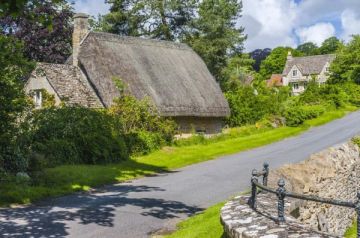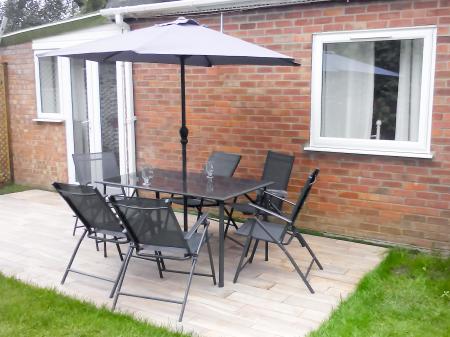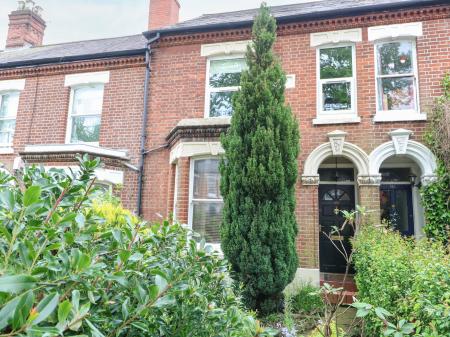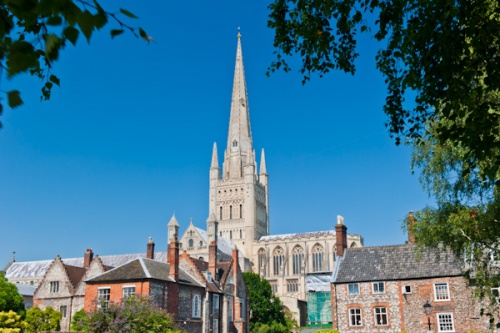
Norwich has worn many hats over the ages. During the Anglo-Saxon era it was a major port, during the Middle Ages it became a centre of the wool and cloth trade. In the 18th century Norwich was known as a banking centre, and in the Victorian era as a hub of shoemaking and engineering activity.
Norwich was founded by the Saxon North Folk ("North Folk" became "Norfolk") at the confluence of the Yare and Wensum rivers sometime around the 6th century. The name Norwich first appeared in the early 10th century.
By the time of the Norman Conquest, the river link made Norwich the third-largest city in England after London and York. William the Conqueror built a castle at Norwich in 1067, using the townsfolk as forced labour, and the present stone castle was built on the same mound some 60 years later.
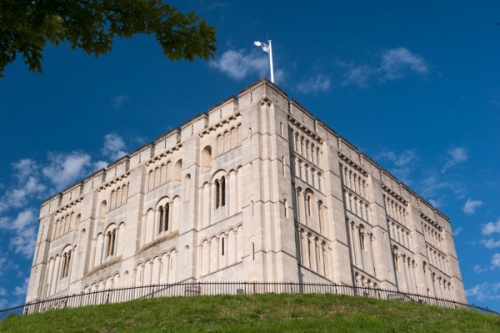
When the castle ceased to be of defensive use it was put to work as the county gaol, a position it held 1220-1887. It is now a museum housing local art, silver, glass, and porcelain, as well as archaeological remains and armour. The dungeon and castle battlements may be visited.
In 1095 the bishopric of East Anglia was moved from Thetford to Norwich, and work was begun on the Cathedral. The cathedral was added to and repaired for several centuries.
A disastrous fire caused considerable damage in the 13th century, and in the 14th century, the spire collapsed. The interior, however, remains wonderfully intact and presents a superb example of Norman architecture. The bishop's throne behind the high altar is the oldest in England, and it contains fragments of the 8th century Saxon cathedral at North Elmham.
Just outside the cathedral is the grave of Edith Cavell, a nurse executed in 1915 for spying by the Germans, after she helped prisoners to escape from a Belgian hospital.
Norwich has 33 churches surviving from the Middle Ages, most built during the prosperous years when Norfolk was a centre of the wool trade. St Peter Mancroft is blessed with a superb hammer-beam roof and 15th century stained glass, while two other churches, St Mary Coslany and St Julian's, date from Saxon times.

The prosperous wool merchants did more than build churches - they built houses for themselves, and Norwich has some of the finest medieval town houses in England. The Bridewell Museum used to be the house of William Appleyard, the first mayor of Norwich in 1404. The name "Bridewell" means prison, and Bridewell House was a prison from 1583-1828. It is now a fine craft museum.
Stranger's Hall, in Charing Cross, is another old merchant house, built in 1520. The name probably refers to its use by immigrant Flemish weavers. It is now a museum of domestic life.
To the south-east of the castle on King Street is Dragon Hall, built in the 15th century by a wealthy merchant as a trading hall. This remarkable timber-framed structure is unique as an English merchant hall in that it was built by a single person rather than a trade guild.
The centre of old Norwich was "Tombland". The name has nothing to do with graveyards, it comes from the old Saxon "tom", meaning empty. The "empty space" here was used as the town market square before the Norman Conquest. Now Tombland houses several fine Georgian shops. The Maids Head Hotel in Tombland dates back to the Middle Ages, and boasts that Queen Elizabeth I slept there in 1578.
The 1407 Guildhall graces the "new" market place. It is now a neighbour to the modern city hall, and the market place is still the shopping and administrative centre of the city after 900 years.

MORE:
Hidden History - Little Known Historic Places in Norwich
Historic Churches - there are over 30 medieval churches in Norwich, plus 2 cathedrals and several historic chapels and meeting houses.
Elm Hill - The prettiest Tudor Street in England.
About Norwich
Address: Norwich,
East Anglia,
Norfolk,
England
Attraction Type: Town
Location map
OS: TG233 084
Photo Credit: David Ross and Britain Express
POPULAR POSTS
HERITAGE
 We've 'tagged' this attraction information to help you find related historic attractions and learn more about major time periods mentioned.
We've 'tagged' this attraction information to help you find related historic attractions and learn more about major time periods mentioned.
Historic Time Periods:
Georgian
Medieval
Saxon
Victorian
Find other attractions tagged with:
10th century (Time Period) - 13th century (Time Period) - 14th century (Time Period) - 15th century (Time Period) - 18th century (Time Period) - 6th century (Time Period) - 8th century (Time Period) - castle (Architecture) - Elizabeth I (Person) - Georgian (Time Period) - Medieval (Time Period) - Norman (Architecture) - Queen Elizabeth (Person) - Saxon (Time Period) - Victorian (Time Period) - William the Conqueror (Person) -
NEARBY HISTORIC ATTRACTIONS
Heritage Rated from 1- 5 (low to exceptional) on historic interest
Norwich Castle - 0.1 miles (Castle) ![]()
The Ethelbert Gate - 0.2 miles (Historic Building) ![]()
Norwich, St Michael at Plea - 0.2 miles (Historic Church) ![]()
Norwich, St John Timberhill - 0.2 miles (Historic Church) ![]()
St George Tombland - 0.2 miles (Historic Church) ![]()
Dragon Hall - 0.2 miles (Historic Building) ![]()
Norwich, All Saints Westlegate - 0.2 miles (Historic Church) ![]()
Armada House - 0.2 miles (Historic Building) ![]()



